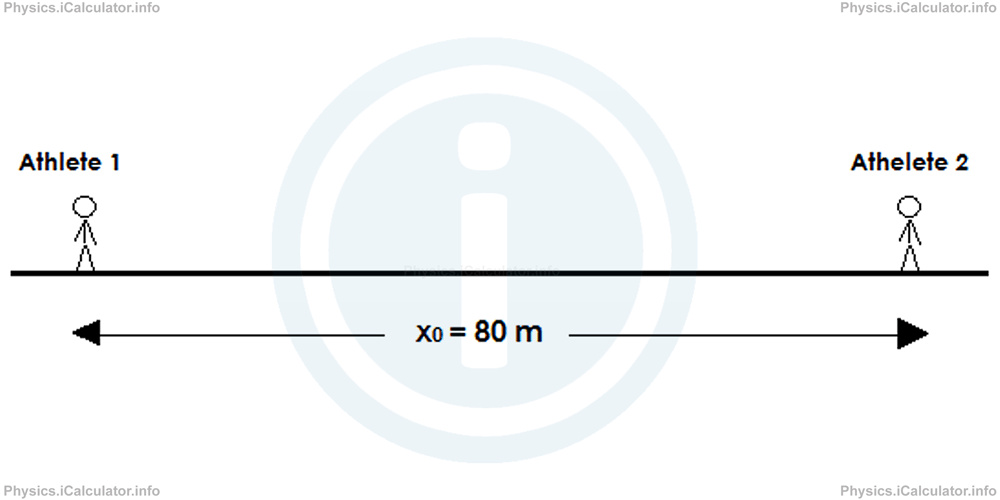Menu
Physics Lesson 3.13.7 - Case 6 - Both the object and the reference frame are moving at constant acceleration
Please provide a rating, it takes seconds and helps us to keep this resource free for all to use
Welcome to our Physics lesson on Case 6 - Both the object and the reference frame are moving at constant acceleration, this is the seventh lesson of our suite of physics lessons covering the topic of Relative Motion, you can find links to the other lessons within this tutorial and access additional physics learning resources below this lesson.
Case 6 - Both the object and the reference frame are moving at constant acceleration.
Depending on the direction of motion of the object and reference frame, we have
Equation 5
x⃗(t) = x⃗0 + v⃗0 × t + a⃗ × t2/2-v⃗'0 × t + a⃗' × t2/2where
- x⃗0 is the position of the object in respect to the reference frame at the initial instant,
- v⃗0 and v⃗0' are the initial velocities of the object and the reference frame respectively,
- a⃗ and a⃗' are the accelerations of the object and the reference frame respectively, and
- t is the time of motion which is the same for both the object and the reference frame.
Example 4
Two athletes are facing each other at 80 m initial distance between them as shown in the figure.

Both athletes are initially at rest, then they start moving towards each other at a⃗1 = 0.6 m/s2 and a⃗2 = 0.4 m/s2 respectively. What is the position of athlete 2 in respect to athlete 1 after 14 seconds?
Solution 4
Let's solve this problem in 2 ways and then, the reader will decide which is more suitable to use.
Method 1
Using equation (5),
and taking the first athlete (the one on the left) as reference frame, we have
= 80 - 0×14+0.4 × 142/2-0×14+0.6 × 142/2
= 80m - 39.2m - 58.8m
= -18m
This result means the second athlete is 18 m on the left of the first one after 14 seconds.
Remark! The sign minus before the first pair of brackets shows that the second athlete (not the one taken as reference frame) is moving towards negative. On the other hand, the sign minus before the second pair of brackets shows that the object (here, the first athlete) is taken as a reference frame, although it is moving towards positive (the minus here is contained in the formula itself, not because the direction of motion).
Method 2
This method is shorter. It consists on taking the relative kinematic quantities between the two athletes, i.e. their approaching velocity v⃗rel = v⃗1 - v⃗2 or the approaching acceleration a⃗rel = a⃗1 - a⃗2 and then applying the equation of motion based only on a set of kinematic quantities, i.e. not using two pair of brackets but the following equation instead,
Equation 6
x⃗(t) = x⃗0 + v⃗0(rel) × t + a⃗rel × t2/2In our example, since the athletes are moving towards each other, we take as relative acceleration the value
(One of the accelerations is taken as negative as the athletes are moving in opposite directions).
Therefore, applying the equation (6), we obtain
= -18m
In this way, we obtained the same results with both methods.
The same approach, i.e. using the concept of relative kinematic quantities can be used in the situations described earlier as well. Hence, we can write v⃗rel instead of v⃗ - v⃗', v⃗0(rel) instead of v⃗0 - v⃗0' and a⃗rel instead of a⃗ - a⃗' in all exercises involving the relative motion. In this way, the calculations become shorter.
Relative quantities can be used in other equations of motion with constant acceleration as well. Therefore, we can write
∆x⃗rel = ( v⃗rel + v⃗0(rel) ) × t/2
v⃗2rel - v20(rel)= 2 × a⃗rel × ∆x⃗rel
You have reach the end of Physics lesson 3.13.7 Case 6 - Both the object and the reference frame are moving at constant acceleration. There are 7 lessons in this physics tutorial covering Relative Motion, you can access all the lessons from this tutorial below.
More Relative Motion Lessons and Learning Resources
Whats next?
Enjoy the "Case 6 - Both the object and the reference frame are moving at constant acceleration" physics lesson? People who liked the "Relative Motion lesson found the following resources useful:
- Case Six Feedback. Helps other - Leave a rating for this case six (see below)
- Kinematics Physics tutorial: Relative Motion. Read the Relative Motion physics tutorial and build your physics knowledge of Kinematics
- Kinematics Revision Notes: Relative Motion. Print the notes so you can revise the key points covered in the physics tutorial for Relative Motion
- Kinematics Practice Questions: Relative Motion. Test and improve your knowledge of Relative Motion with example questins and answers
- Check your calculations for Kinematics questions with our excellent Kinematics calculators which contain full equations and calculations clearly displayed line by line. See the Kinematics Calculators by iCalculator™ below.
- Continuing learning kinematics - read our next physics tutorial: Motion. Types of Motion
Help others Learning Physics just like you
Please provide a rating, it takes seconds and helps us to keep this resource free for all to use
We hope you found this Physics lesson "Relative Motion" useful. If you did it would be great if you could spare the time to rate this physics lesson (simply click on the number of stars that match your assessment of this physics learning aide) and/or share on social media, this helps us identify popular tutorials and calculators and expand our free learning resources to support our users around the world have free access to expand their knowledge of physics and other disciplines.